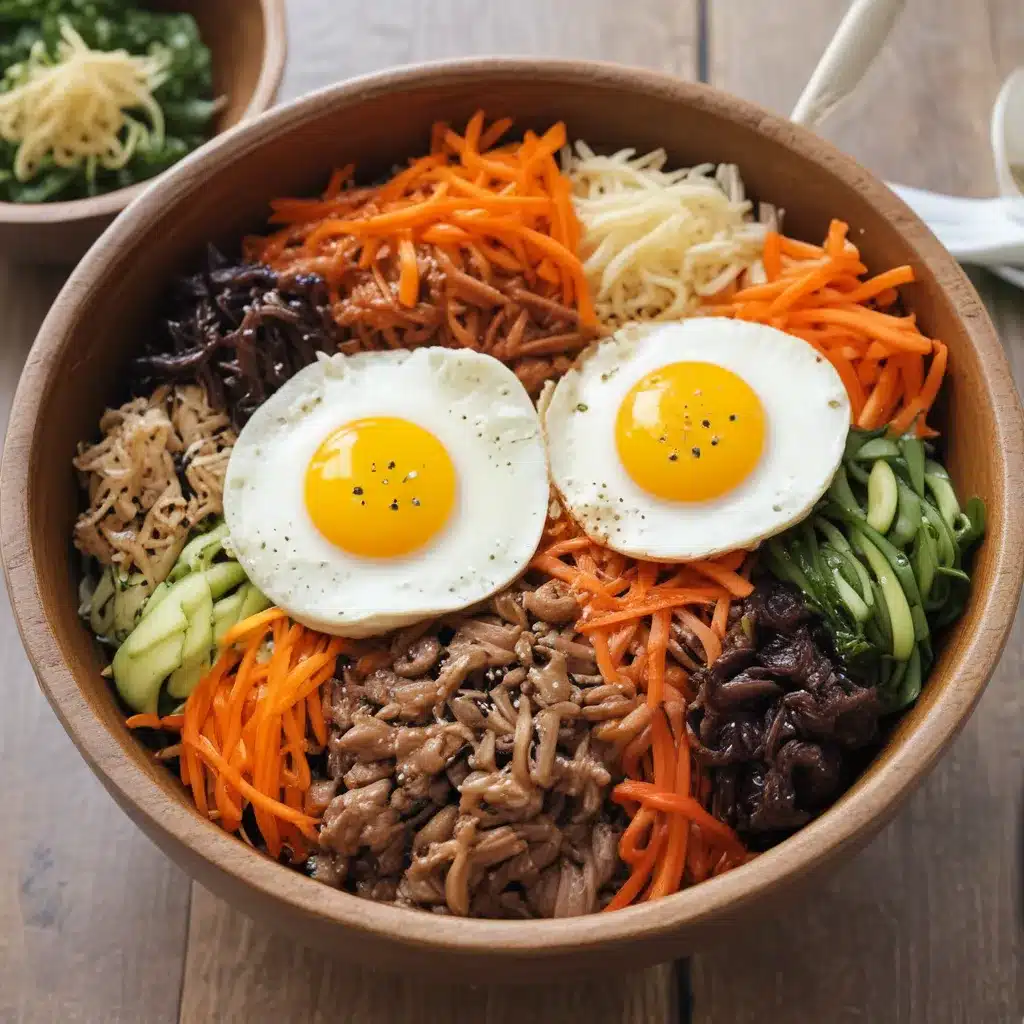
The Origin Story: Bibimbap’s Humble Beginnings
Ah, bibimbap… the mere mention of this dish conjures up images of a vibrant, colorful feast for the senses. But did you know that this quintessential Korean delicacy has its roots in humble, centuries-old traditions? Let me take you on a journey through the origins of this beloved culinary treasure.
You see, the concept of bibimbap can be traced back to the Joseon dynasty in the 15th century. Back then, it was known as “bapsang,” a simple meal where leftover rice was mixed with an assortment of seasoned vegetables. This was a practical way for the working class to stretch their resources and ensure every last morsel was savored. Can you just imagine the resourceful housewives of that era, carefully crafting these flavorful bowls to nourish their families?
As the years passed, bibimbap evolved, incorporating more diverse ingredients and regional variations. The addition of gochujang (Korean chili paste) and other savory condiments transformed it into the vibrant, flavor-packed dish we know and love today. And let me tell you, the story behind how this dish came to be is just as captivating as the dish itself.
The Art of Bibimbap: Crafting the Perfect Balance
Now, let’s dive deeper into the artistry that goes into creating the perfect bibimbap. This dish is not just a simple jumble of ingredients; it’s a harmonious symphony of flavors, textures, and colors. The key lies in striking that delicate balance – a task that requires both skill and a discerning palate.
First and foremost, the foundation of any good bibimbap is the rice. It must be cooked to perfection – fluffy, yet sticky enough to hold the other ingredients in place. The vegetables, carefully selected and prepped, should be crisp, fresh, and bursting with flavor. And let’s not forget the protein, whether it’s tender beef, savory tofu, or a perfectly cooked egg – each element must complement the others, creating a depth of flavor that tantalizes the taste buds.
But the real magic happens when all these components come together, each one playing its part in the grand symphony. The interplay of the warm, comforting rice, the vibrant vegetables, the rich gochujang, and the creamy yolk of the egg – it’s a sensory explosion that simply can’t be matched. I can almost hear the satisfying crunch of the fresh vegetables and the sizzle of the hot stone bowl as I scoop up each delectable bite.
Bibimbap Beyond Borders: Embracing Diversity
One of the most fascinating aspects of bibimbap is its ability to transcend cultural boundaries and appeal to a global audience. As Korean cuisine has gained popularity worldwide, this beloved dish has become a shining ambassador, introducing people to the rich tapestry of Korean culinary traditions.
In fact, I’ve had the pleasure of sampling bibimbap variations from all corners of the globe, and let me tell you, the creativity and ingenuity on display are simply astounding. From the classic Jeonju-style bibimbap in South Korea to the fusion-inspired versions found in trendy eateries from New York to Tokyo, each iteration offers a unique twist that celebrates the diversity of our culinary world.
For instance, have you ever tried a Mexican-inspired bibimbap, with spicy chorizo, avocado, and a sprinkle of queso fresco? Or perhaps a vegetarian version featuring roasted mushrooms, bok choy, and a drizzle of ginger-soy dressing? The possibilities are truly endless, and I’m always eager to discover new and exciting interpretations that push the boundaries of this beloved dish.
Bibimbap: A Culinary Journey of Nourishment and Delight
As I reflect on my love affair with bibimbap, I can’t help but be struck by the profound connection this dish has to the very essence of Korean culture. It’s not just a meal; it’s a celebration of the bounty of the land, a testament to the resourcefulness and ingenuity of the Korean people, and a vessel for the rich tapestry of flavors that defines their culinary heritage.
Each time I savor a steaming bowl of bibimbap, I’m transported back to the bustling streets of Seoul, the lush mountain landscapes, and the cozy family gatherings where this dish takes center stage. It’s a culinary journey that nourishes not just the body, but the soul – a harmonious blend of tradition, creativity, and the pure joy of good food.
And you know, it’s not just the taste that captivates me; it’s the entire ritual of preparing and sharing this dish. The methodical layering of the ingredients, the gentle swirling of the hot stone bowl, the final sprinkle of toasted sesame seeds – it’s a dance of precision and passion that I simply can’t get enough of.
So, whether you’re a seasoned bibimbap enthusiast or a newcomer to this delightful dish, I invite you to join me on this culinary adventure. Explore the depths of its history, marvel at the artistry of its preparation, and savor the boundless diversity that this quintessential Korean rice bowl has to offer. Trust me, once you’ve experienced the joy of bibimbap, your taste buds will be forever changed.
And if you’re ever in the Boston area, I highly recommend checking out Korean Garden, a hidden gem that serves up some of the most authentic and mouthwatering bibimbap I’ve ever had the pleasure of enjoying. Their dedication to preserving the traditions of Korean cuisine while seamlessly integrating local flavors is truly remarkable. So, what are you waiting for? Grab your chopsticks and let’s embark on this delicious journey together!
